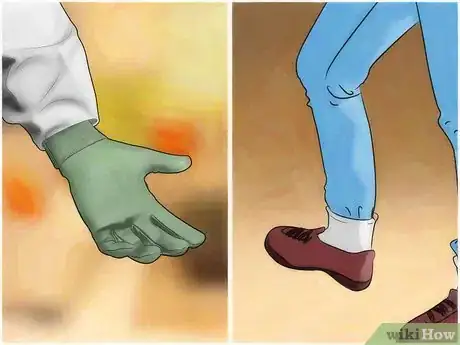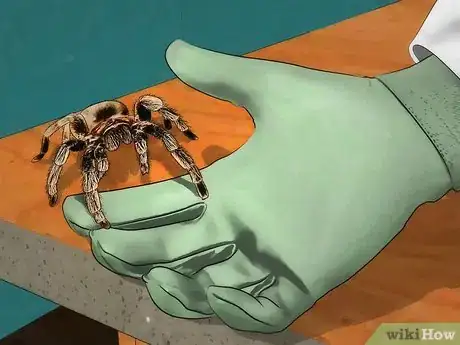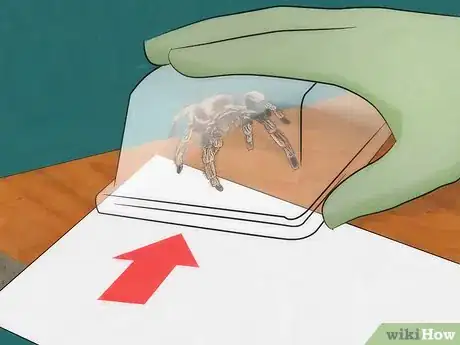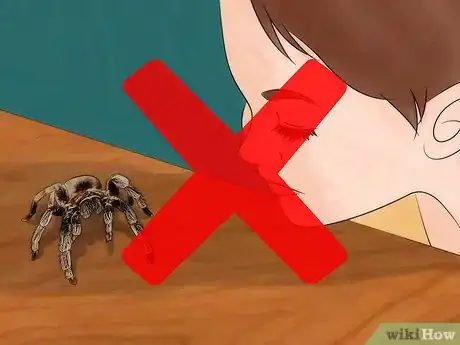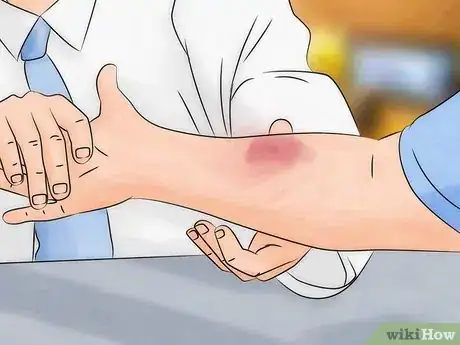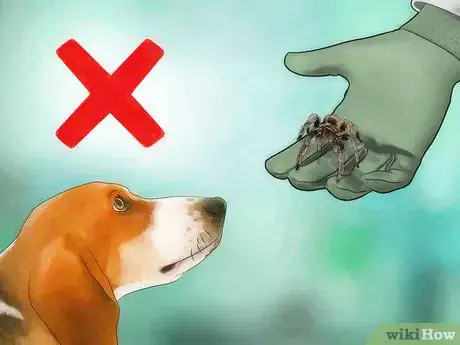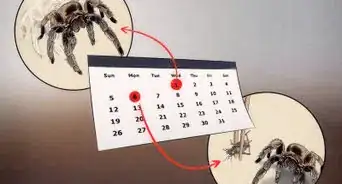This article was co-authored by wikiHow Staff. Our trained team of editors and researchers validate articles for accuracy and comprehensiveness. wikiHow's Content Management Team carefully monitors the work from our editorial staff to ensure that each article is backed by trusted research and meets our high quality standards.
wikiHow marks an article as reader-approved once it receives enough positive feedback. In this case, 90% of readers who voted found the article helpful, earning it our reader-approved status.
This article has been viewed 78,071 times.
Learn more...
Tarantulas are fascinating exotic pets that are fairly easy to care for. While they look fearsome, however, they are surprisingly delicate. They can also leave a painful bite, and some species have irritating hairs. In general, tarantulas should only be observed, not picked up and handled. If you want to or need to do so, following some basic precautions will keep you and your pet safe.
Steps
Handling Your Tarantula
-
1Dress appropriately. Most species of tarantulas kept as pets are not highly dangerous. However, their fangs can be quite long, and they may have special hairs that can irritate humans. To avoid a bite or other injury, wear gloves, long sleeves, and long pants tucked into your socks any time you have to handle your tarantula. You may also want to wear a face mask.
- Of course, you can always attempt to pick up a tarantula without protective clothing. Keep in mind, however, that your risk of getting bit or otherwise injured will be higher.
-
2Be gentle. Though impressive in appearance, tarantulas are fragile. If dropped or squeezed, they can be mortally wounded. Always be very careful when picking up or moving your tarantula.[1]Advertisement
-
3Use forceps and a capture cup. The best way to pick up a tarantula is to use tools that can protect it, rather than your bare hands. A pair of soft foam-tipped forceps can be used to pick up your tarantula, but be sure not to squeeze it. You can also place a capture cup or bowl over the spider, then slide a stiff card underneath, so that you can safely move it. Just be sure not to accidentally clamp the capture cup down on your pet.[2]
-
4Move the tarantula on a flat surface if at all possible. It is much easier to handle a tarantula when it is at a safe level free from obstructions. Work on a broad, flat surface, preferably the floor or the bottom of a bathtub, whenever you need to pick up your tarantula. This will also make it easier to safely use a capture cup.[3]
-
5Don't play around. When picking up or moving your tarantula, keep it away from your face and other exposed skin. If a tarantula is on you or someone else and seems about to attack, flick it away rather than trying to crush it or pick it up. Squeezing or smooshing a tarantula can trigger its bite reflex, making the situation worse.[4]
- Acting calmly and speaking quietly around a tarantula is the best way to be safe and avoid bites. Noise may make it feel threatened and trigger its attack reflex.
- Don't poke your tarantula, or put or pour anything on it. Aggravating a tarantula may make it become aggressive.
- Never wave a tarantula at someone else, even as a joke.
- Know the signs of an impending attack: when a tarantula is threatened, it may raise its rear end and lift its front legs.
- Don't blow on your tarantula, this will also annoy your tarantula and could cause it to run away or attack.
Avoiding Attacks
-
1Determine your pet's species. Many tarantulas are relatively safe pets. However, some are very dangerous and should not be handled at all. Some species are more aggressive than others, so learn more about the variety that you have so that you can know what kind of behavior to expect. It's important to learn about the difference between Old world tarantulas (these are found in Europe, Africa, Asia) and New world tarantulas (found in North America, Mexico and South America). Most New worlds are more docile and easier as first time pets. However, the Old worlds can be move aggressive, fast moving and venomous. This rule doesn't apply to all of either class but is the general rule. There are also arboreal (tree dwelling) and non-arboreal (ground/burrowing), it's important to know what you are wanting to enjoy in your pet before you buy one. You dont want to get a pet in which you can't enjoy or that you can't properly take care of. A great place to start is "The Tarantula Keeper's Guild." by Barrons. This book is inexpensive but invaluable with the knowledge you will gain.[5]
-
2Keep away from a tarantula's jaws. All tarantulas have fangs and can bite. Many species have fangs up to 0.75 inches long. The puppy-sized Goliath tarantula may have fangs up to an inch long. When picking up a tarantula, avoid getting near its jaws (located at the front of its head).[6]
- Clean the wound if you are bitten. Normally, an oral painkiller such as acetaminophen will be enough to ease discomfort. Elevating the wound site can also help relieve pain. If you see signs of infection (redness, swelling, pus, etc.) at the bite site, you should contact a physician for an examination.
- You may be more likely to encounter pain or other problems if you are bitten in a sensitive area, such as your face.
- If you have a known allergy to tarantula bites, you should be extremely cautious when picking up a tarantula. Seek medical attention immediately if you have an allergy and are bitten, or if you experience signs of an allergic reaction, such as extreme swelling or difficulty breathing.
-
3Avoid touching the tarantula's abdomen. Some species of tarantula have special “urticating” hairs with chemical irritants on their abdomens. They will shed these when touched, and can even shed clouds of thousands of them at a time. These can be painful to the touch, cause redness and swelling of the skin, and irritate the eyes and nose. In some cases, they will need to be surgically removed. [7]
- If you see a tarantula rearing up, get away.
- Always wash your hands after handling a tarantula.
- Wearing a face mask and gloves can help protect you from urticating hairs.[8]
- If urticating hairs do get on your skin, peel them of with tape and take an antihistamine, like Benadryl.
-
4See a doctor if necessary. If you get urticating hairs in your eyes, are bitten by a tarantula in a sensitive area (such as your eye), or have a bite wound that may be infected, call a doctor. Medical attention may be necessary to treat these complications.[9]
-
5Keep them away from other pets. Even if they are relatively safe to humans, tarantulas can be lethal to other pets, such as dogs. Always keep your tarantula in a safe, secure enclosure. Keeping your tarantula and other pets separated from each other will help keep everyone safe.
Community Q&A
-
QuestionCan a tarantula kill a human?
 Community AnswerNo, their venom isn't strong enough to kill a human. The bite will cause pain and swelling, however, much like a bee sting.
Community AnswerNo, their venom isn't strong enough to kill a human. The bite will cause pain and swelling, however, much like a bee sting. -
QuestionWhat is the lifespan of a tarantula?
 Community AnswerIt depends on the species. Most species reach adulthood around 5 years old, and others around 10 years old. After reaching adulthood, a male tarantula will usually live another 1-2 years, but a female tarantula can live much longer, even up to 40 years or so.
Community AnswerIt depends on the species. Most species reach adulthood around 5 years old, and others around 10 years old. After reaching adulthood, a male tarantula will usually live another 1-2 years, but a female tarantula can live much longer, even up to 40 years or so. -
QuestionCan I stroke them if I use gloves?
 Community AnswerI wouldn't suggest stroking them, since they're very fragile and even the slightest pressure can rupture their abdomen.
Community AnswerI wouldn't suggest stroking them, since they're very fragile and even the slightest pressure can rupture their abdomen.
References
- ↑ http://blogs.cornell.edu/spiders/tarantulas-terrible-or-terrific/
- ↑ http://blogs.cornell.edu/spiders/tarantulas-terrible-or-terrific/
- ↑ http://blogs.cornell.edu/spiders/tarantulas-terrible-or-terrific/
- ↑ http://people.ucalgary.ca/~schultz/roses.html
- ↑ http://www.uky.edu/Ag/CritterFiles/casefile/bugconnection/petbugs/exotic/exotic.htm
- ↑ http://www.uky.edu/Ag/CritterFiles/casefile/bugconnection/petbugs/exotic/exotic.htm
- ↑ http://blogs.cornell.edu/spiders/tarantulas-terrible-or-terrific/
- ↑ http://citeseerx.ist.psu.edu/viewdoc/download?doi=10.1.1.494.8568&rep=rep1&type=pdf
- ↑ http://poisoncontrol.uchc.edu/about_poisons/outdoor/articles/arachnophobia.html
About This Article
To pick up a tarantula, it's best to wear gloves and long sleeves to protect against bites, especially if you've never held the tarantula before. Next, move the tarantula to a flat surface and gently pick it up with a pair of foam tipped forceps. You can also place a capture cup over the spider and slide a stiff card underneath to pick it up. If you notice the spider raising its rear end and lifting its front legs, it may be preparing to bite, so be sure to keep it away from your face and any exposed skin. For tips on treating a tarantula bite, read on!
